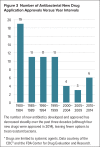The antibiotic resistance crisis: part 1: causes and threats
- PMID: 25859123
- PMCID: PMC4378521
The antibiotic resistance crisis: part 1: causes and threats
Abstract
Decades after the first patients were treated with antibiotics, bacterial infections have again become a threat because of the rapid emergence of resistant bacteria-a crisis attributed to abuse of these medications and a lack of new drug development.
Figures



Similar articles
-
The beginning of the end of the antibiotic era? Part II. Proposed solutions to antibiotic abuse.Quintessence Int. 1998 Apr;29(4):223-9. Quintessence Int. 1998. PMID: 9643260 Review.
-
Tackling Threats and Future Problems of Multidrug-Resistant Bacteria.Curr Top Microbiol Immunol. 2016;398:3-33. doi: 10.1007/82_2016_492. Curr Top Microbiol Immunol. 2016. PMID: 27406189 Review.
-
Emergence of Global Antibiotic Resistance.Prim Care. 2018 Sep;45(3):467-484. doi: 10.1016/j.pop.2018.05.006. Prim Care. 2018. PMID: 30115335 Review.
-
Emerging antibiotic resistance: carbapenemase-producing enterobacteria. Bad new bugs, still no new drugs.Infez Med. 2019 Dec 1;27(4):357-364. Infez Med. 2019. PMID: 31846984 Review.
-
Current and emerging drugs for acute bacterial skin and skin structure infections: an update.Expert Opin Emerg Drugs. 2014 Sep;19(3):431-40. doi: 10.1517/14728214.2014.955015. Epub 2014 Aug 22. Expert Opin Emerg Drugs. 2014. PMID: 25146459 Review.
Cited by
-
Impact of FtsZ Inhibition on the Localization of the Penicillin Binding Proteins in Methicillin-Resistant Staphylococcus aureus.J Bacteriol. 2021 Jul 22;203(16):e0020421. doi: 10.1128/JB.00204-21. Epub 2021 Jul 22. J Bacteriol. 2021. PMID: 34031040 Free PMC article.
-
De Novo Resistance to Arg10-Teixobactin Occurs Slowly and Is Costly.Antimicrob Agents Chemother. 2020 Dec 16;65(1):e01152-20. doi: 10.1128/AAC.01152-20. Print 2020 Dec 16. Antimicrob Agents Chemother. 2020. PMID: 33046494 Free PMC article.
-
Distribution and genetic diversity of multi-drug-resistant Klebsiella pneumoniae at the human-animal-environment interface in Pakistan.Front Microbiol. 2022 Sep 6;13:898248. doi: 10.3389/fmicb.2022.898248. eCollection 2022. Front Microbiol. 2022. PMID: 36147844 Free PMC article.
-
Multisubstituted pyrimidines effectively inhibit bacterial growth and biofilm formation of Staphylococcus aureus.Sci Rep. 2021 Apr 12;11(1):7931. doi: 10.1038/s41598-021-86852-5. Sci Rep. 2021. PMID: 33846401 Free PMC article.
-
Antibiotic Resistance in Pediatric Infections: Global Emerging Threats, Predicting the Near Future.Antibiotics (Basel). 2021 Apr 6;10(4):393. doi: 10.3390/antibiotics10040393. Antibiotics (Basel). 2021. PMID: 33917430 Free PMC article. Review.
References
-
- Golkar Z, Bagazra O, Pace DG. Bacteriophage therapy: a potential solution for the antibiotic resistance crisis. J Infect Dev Ctries. 2014;8(2):129–136. 13. - PubMed
-
- Wright GD. Something new: revisiting natural products in antibiotic drug discovery. Can J Microbiol. 2014;60(3):147–154. - PubMed
-
- Centers for Disease Control and Prevention, Office of Infectious Disease Antibiotic resistance threats in the United States, 2013. Apr, 2013. Available at: http://www.cdc.gov/drugresistance/threat-report-2013. Accessed January 28, 2015.
LinkOut - more resources
Full Text Sources
Other Literature Sources
